Among the starry-eyed performers who make up regional acting collectives—a starting point for aspiring dramatists and comedians alike—a sense of community is palpable.
Even for those who go on to attain a prominent position in the fickle entertainment industry, whether regionally or globally, the earliest memories of honing their craft remain strong. Sandra Oh, a performer of both stage and screen born to South Korean immigrant parents in Nepean, Ontario, is endlessly grateful for her early experiences in Ottawa’s bustling improv scene. Speaking over the phone from Los Angeles, she reveals, “I had great training in Canada”; she was also fortunate enough to be in close geographical proximity to the larger Canadian improv community during a time of great expansion. “When I was in high school, the Canadian Improv Games were moving from Ottawa into a much wider Canadian arena. I also had all the people who started the Canadian Improv Games teach me directly.”
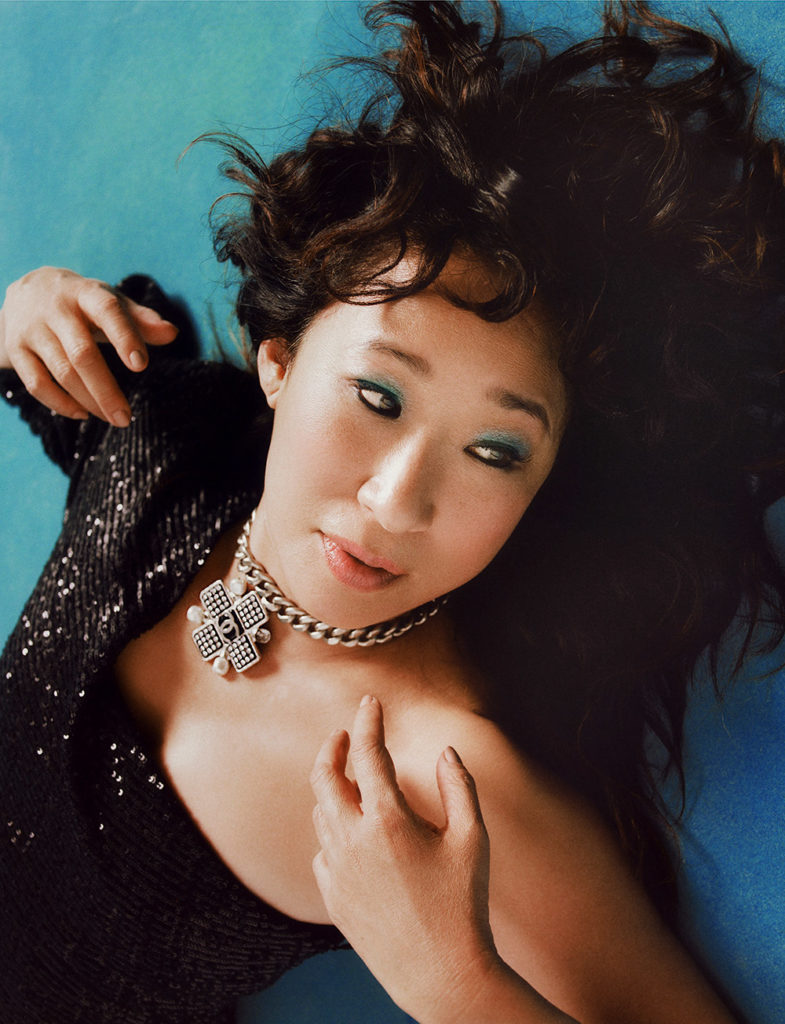
Full look by CHANEL.
After high school, the burgeoning actor enrolled in the National Theatre School, where she received mentorship from a pre-eminent educator in the field. “I went to the NTS during the Perry Schneiderman reign. We were his first class, and we got extraordinary training. He’s an amazing artistic director, and we luckily got him!” While there may be an element of divine will present in the early opportunities Oh was afforded, it was her perseverance that ultimately proved to be fruitful in establishing her as a performer in a league of her own. Oh remains in touch with her peers from those formative years, acknowledging that “I know the people who run [the Canadian Improv Games] now because those are the people who were around when I was in improv. I’m so happy that the mantle has been passed to them—they are really keeping the spirit alive.”
After graduating, Oh used her extensive knowledge and insight to break into the industry with aplomb, appearing in Canadian-based productions before going international. From there, Oh built a reputation as an actor with the ability to slip into her assigned characters with an effortless naturalism while also flaunting a versatility that encompasses various styles of acting. From stealing the scene with spot-on comedic timing as vice principal Geraldine Gupta in The Princess Diaries to portraying a viticulture enthusiast in Sideways, her acting resumé is eclectic and varied. Audiences will most likely recognize Oh from her role as Dr. Cristina Yang on the prime-time medical drama Grey’s Anatomy. Throughout a robust 10-season run, Oh characterized Dr. Yang as an ambitious individual whose quest for professional perfection ultimately led to humanizing moments of self-doubt and emotional vulnerability.
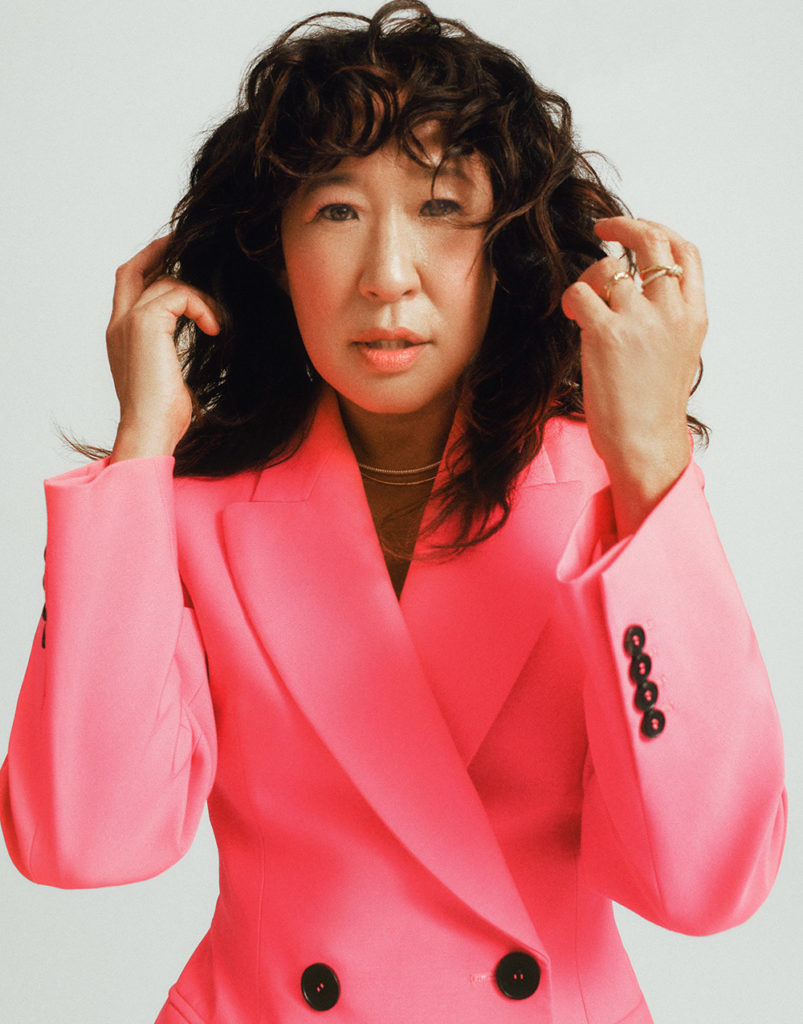
Suit by Alexander McQueen; necklace and rings by Tiffany & Co.
Since then, Oh has brought to life an equally compelling—if sometimes polarizing—character in Eve Polastri, an MI5 secret agent in the BBC spy thriller Killing Eve, which is now entering its fourth and final season. When audiences first meet Eve, she is a renegade government official with an unrelenting drive to uncover a Russian assassin by the name of Villanelle who is tasked with murdering prominent political figures from around the globe. However, as the show progresses and Eve’s association with Villanelle greatly intensifies, the ensuing narrative arc sees this protagonist explore facets of her own persona that have undergone a seemingly irreversible transformation. “It’s Eve meeting Villanelle that’s transformed her forever,” Oh admits, “because Villanelle ignited and continues to ignite all these facets within Eve as a full human being.” Over the first three seasons, viewers are given a nuanced and harrowing portrait of the female psyche in all its complexity. “Eve and Villanelle are trying to come into more wholeness, and they can only do it through each other,” Oh explains. This is evident in Eve’s descent into moral ambiguity, which, Oh says, only intensifies in the fourth season. “The body at the beginning of the show and the body of Eve in season four is vastly divergent. It’s just a completely different person—the whole attitude, the confidence, and the trauma is different.” As for Villanelle, Eve has allowed her to confront her own humanity in ways she had not explored previously, discovering in fragments what it truly means to be an empathetic individual.
The pair’s symbiosis has also shrouded their bond in a beguiling ambiguity, especially considering Eve’s constant push and pull with Villanelle. “There is so much openness in people’s interpretation of their relationship,” Oh reveals, which allows the audience to hypothesize about what consistently drives Eve back into Villanelle’s brute embrace. Oftentimes, it can seem platonic, but there also appears to be a strong interpersonal—and slightly romantic—fixation between the two that allows Eve to see past Villanelle’s steely exterior as a ruthless killer for hire.
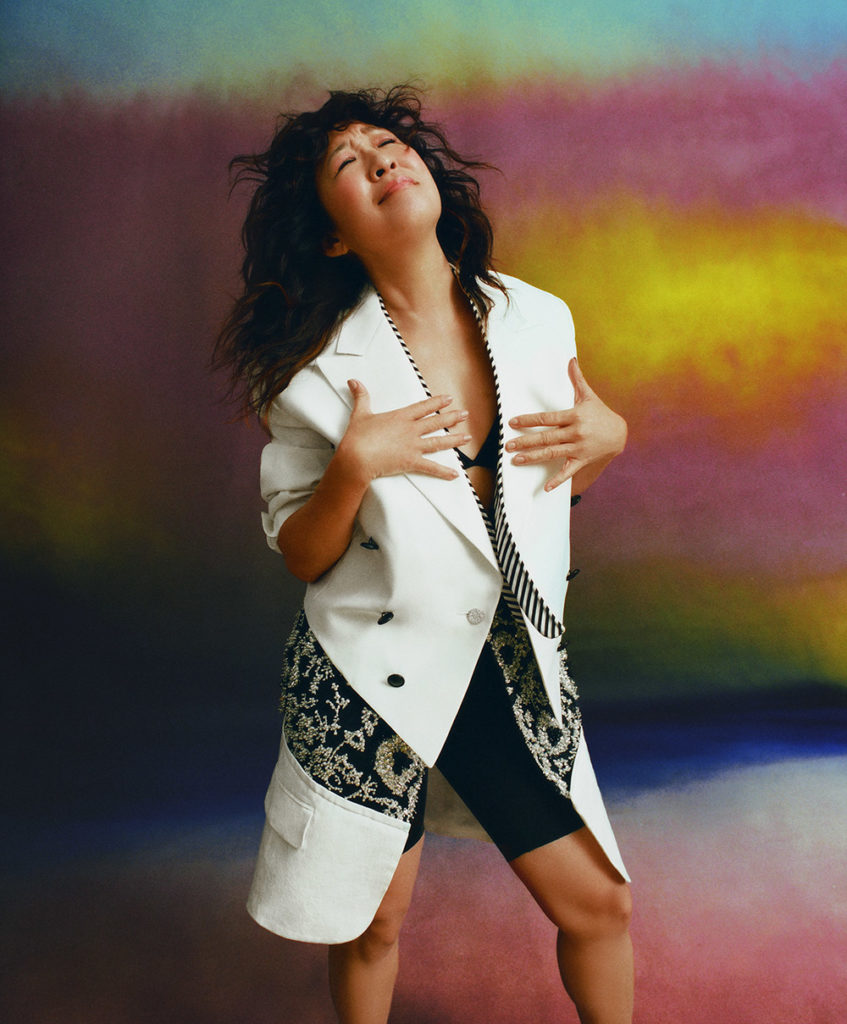
Full look by Louis Vuitton.
Perhaps it is Eve’s gradual shift into a femme fatale figure that engrosses Villanelle—which, in comparison to typical portrayals in television and film, is a welcome alternative. “I think Eve’s femme fatale takes that past understanding of the archetype and brings a woman of colour into it, who is past the age of 20, which allows for much more depth,” Oh says. Rather than adhering to a certain aesthetic, Eve proves that the notion of a femme fatale is more cerebral than previously understood. “She’s middle-aged, she’s Asian, she’s not like one of those famous Old Hollywood actresses. She really proves that it’s ultimately an attitude, and one that is hidden behind her appearance as a normal, everyday woman.”
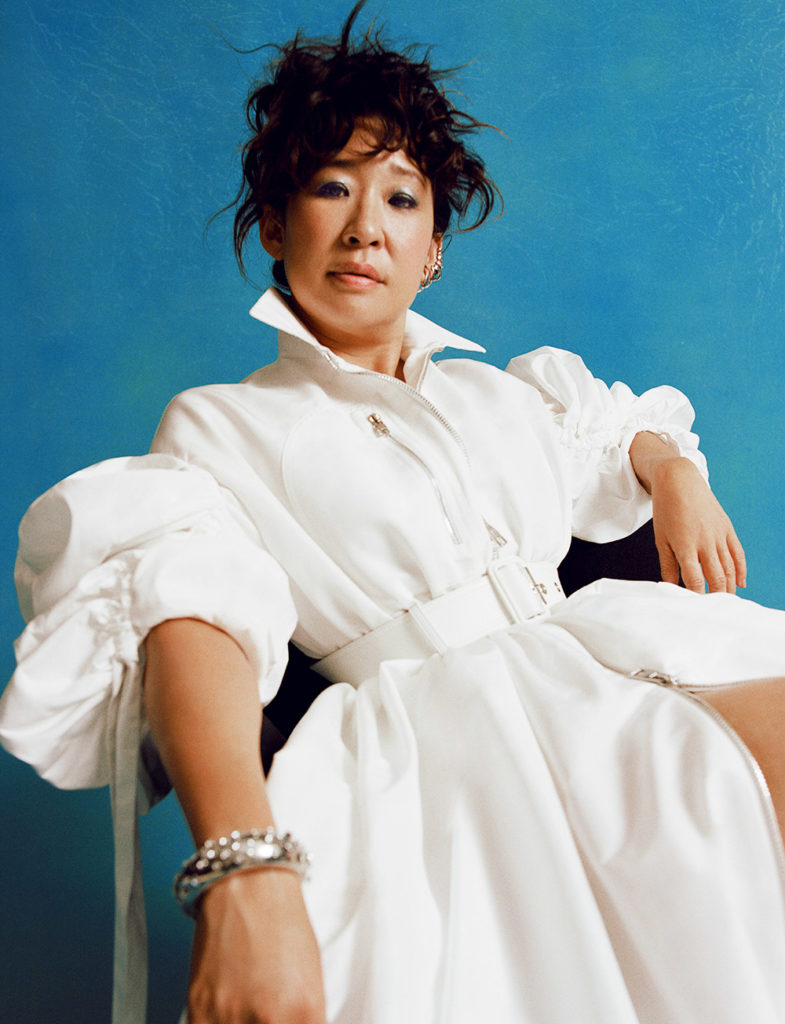
Dress and jewellery by Alexander McQueen.
Moving behind the camera as an executive producer on Killing Eve has allowed Oh to play a larger role in Eve’s character development, a first for the actor. Having previously collaborated with writers during her tenure on Grey’s Anatomy, Oh took this opportunity to create a “much richer creative experience,” while also gaining “complete ownership of Eve Polastri.” However, getting to this place involved serious dedication and commitment, and Oh admits that “it took me a very long time to gain that seat and present all the skills to become a primary collaborator on this level.”
Aside from the concluding chapter of the Killing Eve saga, she can also be seen in the Netflix original series The Chair, a critically acclaimed dramedy that centres around Ji-Yoon Kim (Oh), the first woman to become the chair of the English department at Pembroke University. This fictional narrative follows Kim as she navigates her new-found professional advancement, a not-so-platonic rapport with a fellow scholar, and a fraught relationship with her adoptive daughter.
In a tonal shift to a much more lighthearted affair, Oh will be lending her voice to the big-budget Pixar production Turning Red. Set in Toronto during the early aughts, the story follows a tween girl named Mei Lee who, through a family curse, transforms into a giant red panda when triggered by intense emotions. Oh voices her lovingly overbearing and overprotective mother, who has a few repressed demons of her own to tend to throughout the story.
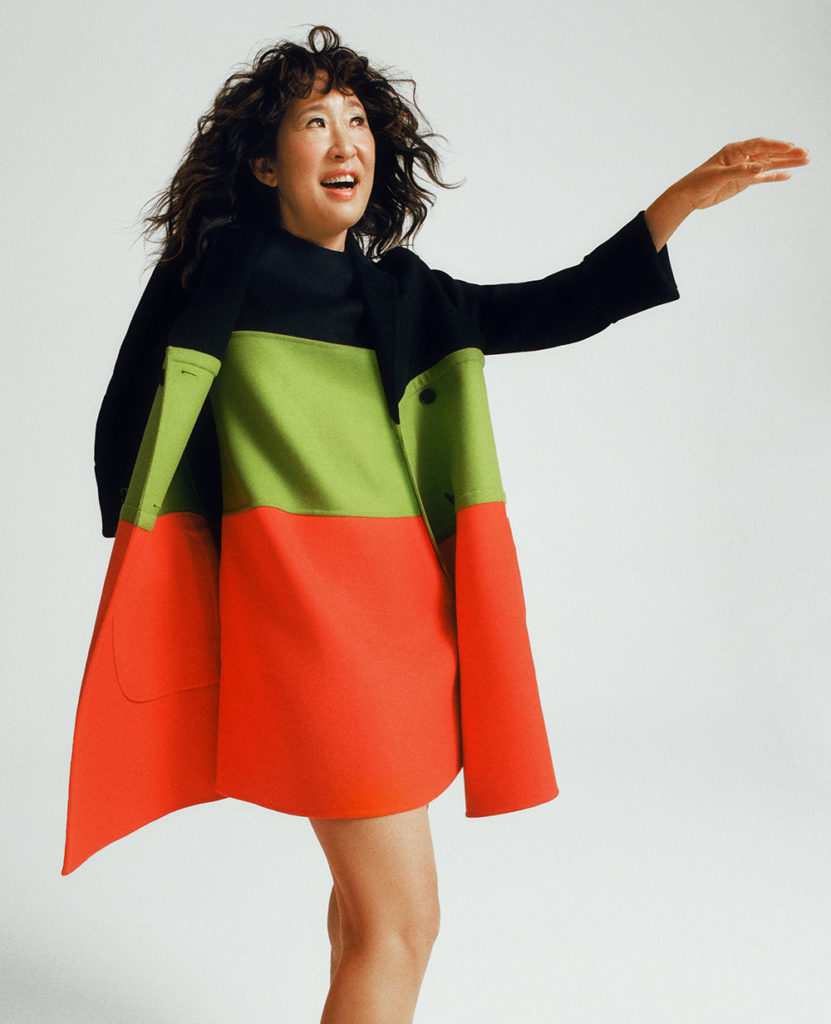
Dress and coat by Dior; earrings by Tiffany & Co.
Upon receiving the script, the actor was elated to take part in this intensely Canadian project that featured a very familiar topography. “When this film came down and I got a call for it, I was like, ‘Oh my god, it’s Toronto!’ In the opening sequence, when Mei gets on the bus and arrives at her family’s temple, I could recognize the intersection at Dundas and Spadina, and I remember saying, ‘I know that corner, I know that street!’ I really thought the animators just did such a great job with recreating a more authentic feeling of the city during that time.”
One aspect that the animators and creators of the film were able to genuinely capture, aside from notable landmarks, is the diversity prevalent throughout the downtown core. “The individuals working on the project were also able to showcase how multicultural Toronto is,” Oh excitedly exclaims. “The film centres on a group of girls from different ethnic backgrounds—even Mei’s teacher had an accent. That especially stood out for me, because that was how my teachers were when I was in school. It all seemed very honest.”
What Oh and the creators of the film hope audiences (especially pre-teen and tween girls) will take away from Turning Red is the power of female friendships. “I just want girls to hopefully see themselves in one of these characters. They’re all smart and not afraid of it, and they’re entrepreneurial!” she states. “It’s a film about that time in your life when you need to move away from your family and you become dependent on your friends. It’s a beautiful tale of how girls stick together and support one another.” Turning Red makes the pangs of puberty seem both relatable and life-affirming.
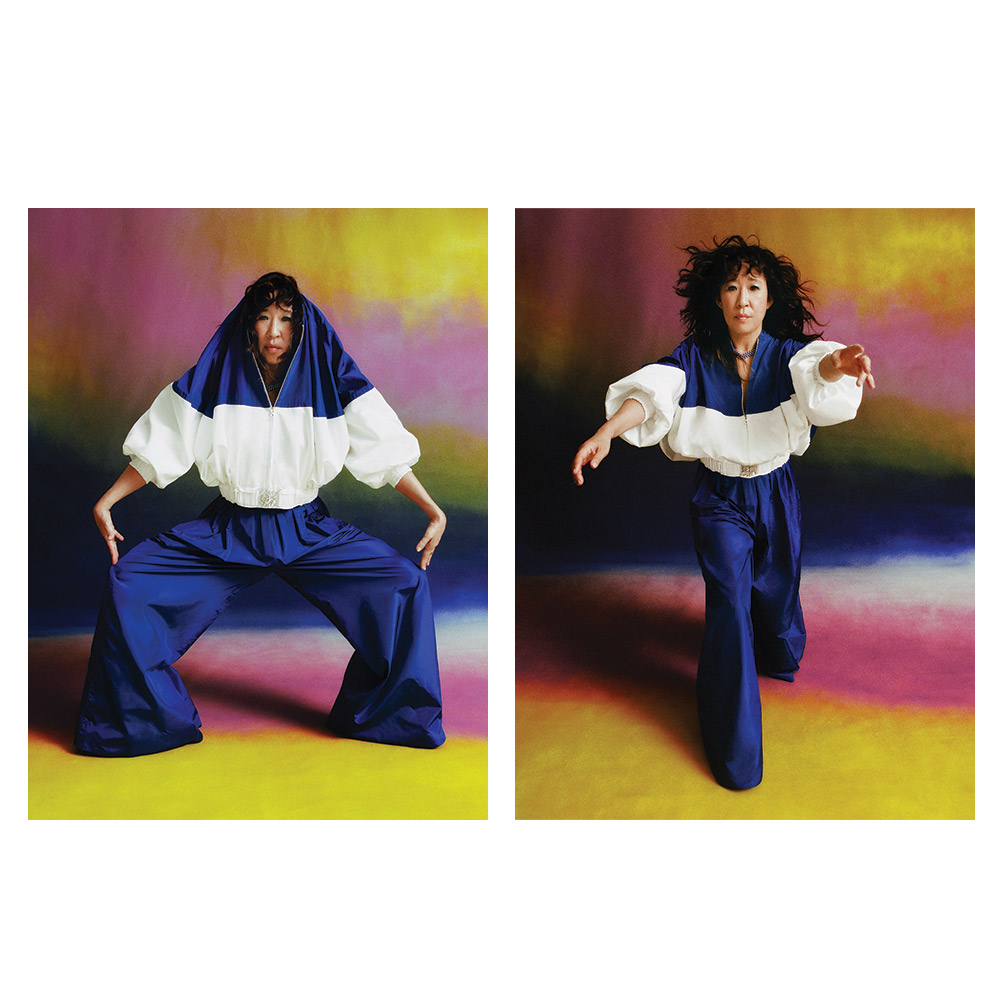
Jacket and pants by Loewe; rings by Cartier; necklace by Van Cleef & Arpels; shoes by Christian Louboutin.
Sony Pictures’ much-anticipated spring release Umma, named after the Korean word for mother, sees the actor assume a different matriarchal role. The film details the relationship between a daughter and a mother (played by Oh), and the impact of generational trauma as they manage a life in solitude as beekeepers. Written and directed by Iris K. Shim, this supernatural thriller is the first major studio production helmed by a Korean–American woman, a milestone in the entertainment industry.
With the extensive body of work Oh has amassed, the actor has the luxury of being able to choose projects that compel her. What drives Oh to participate in a television or film production boils down to one innate feeling. “Valuing life and wanting to help make this world a better place is constantly a motivating factor in choosing these stories, especially since the pandemic and several racial justice movements have shaken society to the core.” She continues to note how “a creative spirit is constantly in motion—it isn’t a stagnant thing.” In this case, Oh’s creative and curious spirit is moving at a thrilling pace as her audience hangs on tight and enjoys the captivating ride.
By David Saric
Photography by Leeor Wild (Sarah Laird & Good Company)
Styling by Petra Flannery
Makeup by Jo Strettell (Walter Schupfer Management)
Hair by Jenny Cho (A-Frame Agency)
Manicure by Shigeko Taylor (Star Touch Agency)
Stylist Assistant: Violet Somers
Production by Caroline S. Hughes for Hyperion LA
Photo Assistants: Patrick Molina, Ahmad K. Smith, Kristina Dittmar

